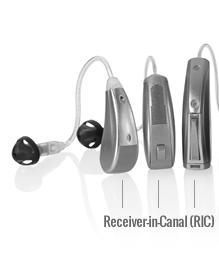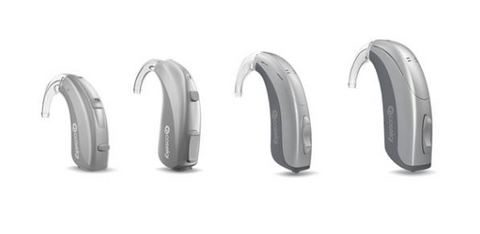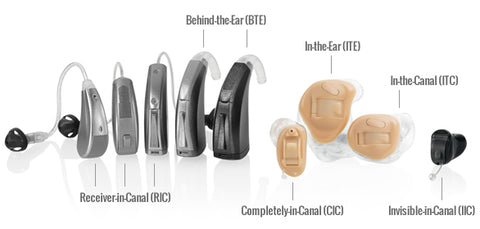Hearing Aid Types
Types of Hearing Aids
Hearing aids come in a range of shapes and sizes, but the right one for you will usually depend on your level of hearing loss.
To find the best type of hearing aid for you depends on the following factors:
- What type and level of hearing loss you have
- The size of your ear canal
- Your lifestyle
- Cosmetics
- Budget
Some hearing aids are available on the NHS, while others will usually need to be bought privately. Both have Pros and Cons with private hearing aids usually having more and better features including rechargeable options.
In-the-ear and in-the-canal hearing aids

In-the-ear (ITE) hearing aids and in-the-canal (ITC) hearing aids both have microphones in the earmould. This means the whole hearing aid fits into your ear.
ITE aids come in different sizes, but they can all be seen in the ear from the side.
ITC aids are smaller and less visible, as they fit inside your ear canal.
Who this is most suitable for
People with mild to severe hearing loss.
They’re not likely to be suitable if you have ear infections often or have very small ear canals. If you have trouble using small controls, ITC hearing aids may not suit you unless they can be controlled remotely.
Receiver-in-the-ear and receiver-in-the-canal hearing aids

Receiver-in-the-ear (RITE) and receiver-in-the-canal (RIC) are similar to open-fit behind-the-ear (BTE) hearing aids.
The part of the hearing aid behind the ear is smaller than BTE hearing aids. It has a thin wire that connects to a speaker inside the opening of the ear.
RITE and RIC hearing aids are also less visible than BTE hearing aids.
Who this is most suitable for
People with mild to profound hearing loss.
Completely-in-the-canal hearing aids

Completely-in-the-ear canal (CIC) hearing aids fit further into your ear canal than in-the-canal (ITC) aids.
They’re not usually visible unless someone looks closely at your ear. It’s unlikely they’ll have features like a hearing loop setting, because they’re too small to fit the technology.
Who this is most suitable for
People with mild to moderate hearing loss.
They’re not suitable for people who often get ear infections, or find fiddly tasks difficult.
How to get this hearing aid
CIC aids are available privately, book a hearing test and discover the world of CIC hearing aids.
Invisible-in-the-canal hearing aids

Invisible-in-the-canal (IIC) hearing aids are fitted very deeply in the ear canal.
Some IIC models stay in your ear for a few months at a time. These can only be removed by your audiologist, who will maintain and clean the hearing aid for you.
There are other models that you can take out of your ear yourself.
Because of their small size, they might have limited features.
Who this is most suitable for
People with mild to moderate hearing loss.
How to get this hearing aid
IIC aids are only available privately, book a hearing test and discover the world of CIC hearing aids.
Behind-the-ear hearing aids

Behind-the-ear (BTE) hearing aids have microphones that sit behind the ear. These pick up sound and process it digitally to make it louder and clearer.
BTE hearing aids with earmoulds
These send sound through a piece of clear, flexible tubing. This is connected to an earmould that is custom-made to fit inside your ear.
Who this is most suitable for
People with mild to profound hearing loss.
Open-fit BTE hearing aids
These send sound through very thin, clear tubing connected to a small, soft tip (called a dome) that sits inside your ear canal. This is known as an open fitting.
This type of hearing aid lets you hear some sounds naturally, such as low pitches, as it does not block up the ear.
Who this is most suitable for
People with mild to moderate hearing loss. It’s a good option for people who can hear low pitches well.
It’s not likely to be suitable if you have ear infections often, or find fiddly tasks awkward as cleaning them could be difficult.
CROS and BiCROS hearing aids
CROS and BiCROS hearing aids are for people who have hearing in only one ear.
These are made up of a conventional hearing aid that sits in the hearing ear, and a microphone that looks like a hearing aid, which sits in the ear with no hearing.
CROS (contralateral routing of sound) hearing aids pick up sound from the side with no hearing and feed it into the hearing ear. This type of hearing aid is for people who have good hearing in their hearing ear.
BiCROS (bi-contralateral routing of sound) aids amplify sound from both sides and feed it into the ear with better hearing. This hearing aid is for people who have hearing loss in their hearing ear.
Benefits of CROS and BiCROS hearing aids
These hearing aids are especially good for certain situations. It means you don’t have to make sure people speak into your ‘good’ ear.
You will also be more aware of other noises around you.

